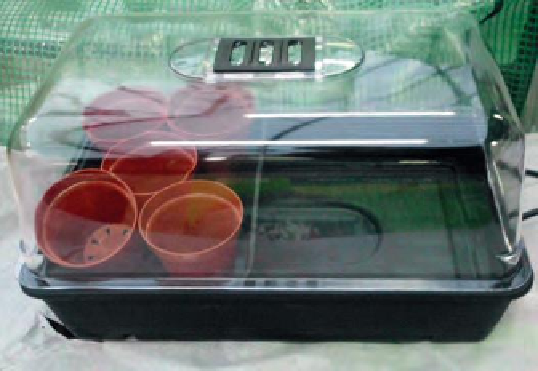Agriculture Reference
In-Depth Information
Seed composts
11
These are commonly equal parts peat or peat
alternative and sand or perlite or vermiculite mixes.
They include lime except for 'lime-hating' specimens
(see p. 182) and a source of phosphate. Seedlings are
transferred to
potting composts
,
where the young
plants are established, which have a higher proportion
of peat or alternatives with lime and a full range
and higher concentration of nutrients. Increasingly
alternatives to peat are being utilized (see p. 182) and
many advocate the use of sterilized loam because it
makes the nutrient management easier (see compost
formulations, p. 181).
Sowing seeds
Figure 11.4
Propagator. These can range from the
very simple ones providing just a humid atmosphere
to those providing some ventilation and warmth
The sowing of medium seed such as
Lactuca sativa
(lettuce) and
Solanum lycopersicon
(tomatoes)
is shown on the companion website. After the
container has been filled with compost it is lightly
firmed to just below the rim of the container using
an appropriately sized presser board. Seeds are then
sown on the surface at the rate recommended.
Many advocate that when using trays, half the
seed is sown then, to achieve an even distribution,
the other half is sown after turning the container
through 90 degrees. The seeds are then covered
with sieved compost or fine grade vermiculite to
their own thickness. Fine seeds such as
Begonia
semperflorens
are sown in equal parts of fine dry
sand to help achieve an even distribution. They
are lightly pressed into the surface and then left
uncovered. Large seed such as
Cucurbita pepo
(courgettes) or pelleted seed tends to be 'space
or station sown', that is, placed at recommended
distances in a uniform manner.
The seed containers should be labelled with name
of plant and the sowing date. The compost is then
watered from a can fitted with a fine rose. Water
is more gently delivered with the holes of the rose
pointing upwards. Standing pots in water is likely to
create a problem because the compost becomes fully
saturated and air is driven out when there is a need
for oxygen. The popularity of perlite or vermiculite
to cover seeds is largely because they offer moist
conditions whilst allowing oxygen to reach the
developing seeds and seedlings.
The moist conditions around the seed must be
maintained, which is most easily done by covering
with a sheet of glass, clear plastic or kitchen film.
The container should be kept in a warm place
(approximately 20°C). If necessary, a sheet of paper
can be used to shade the seeds from the direct
sunlight and to minimize temperature fluctuations.
There are advantages in placing the seed containers in
a closed propagator (Figure 11.4).
Covers on the container should be removed as soon
as the seedlings appear and they must now be well
lit to avoid
etiolation
(see p. 68), but not exposed
to strong sunlight. Watering must be maintained but
without waterlogging the compost.
In production horticulture, much of the work is done
by machines. Pots are rarely filled by hand and
increasingly the whole process is automated including
the seed sowing.
Pricking out
When the seedlings are large enough to be handled,
they should be transplanted into a potting compost
prepared as for the seed tray. Each seedling is eased
with a dibber, lifted by the seed leaves, dropped into
a hole made in the new compost, gently firmed and
watered in. The seedlings are normally planted in rows
with space, typically 24 to 40 per seed tray, for them
to grow on to the next stage (Figure 11.5)
Many will be planted out when ready but others will
continue in containers so they are '
potted off
' (moved
into another container) to give them more space. They
are then '
potted on
' when they outgrow this container
or planted out. As they are moved to the next size
container, it is a mistake to go to a much larger
container, the compost, especially the nutrient level, is
chosen to suit the stage reached (see JIP p. 181).
Hardening off (acclimatization)
This
is required to ensure that the seedlings raised in
a protected environment can be put out into the open


